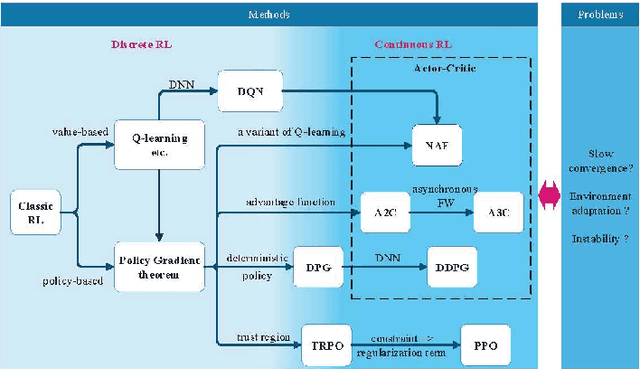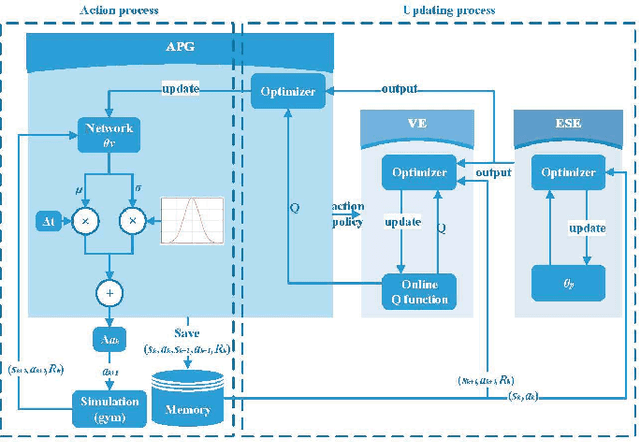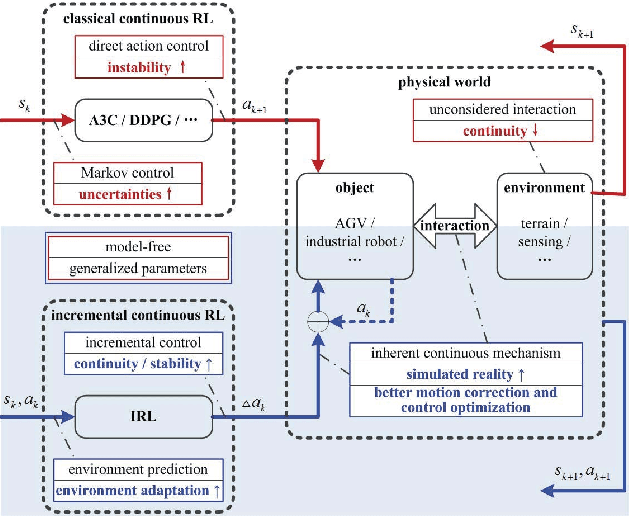Tianhao Chen
Teaching LLMs According to Their Aptitude: Adaptive Reasoning for Mathematical Problem Solving
Feb 17, 2025



Abstract:Existing approaches to mathematical reasoning with large language models (LLMs) rely on Chain-of-Thought (CoT) for generalizability or Tool-Integrated Reasoning (TIR) for precise computation. While efforts have been made to combine these methods, they primarily rely on post-selection or predefined strategies, leaving an open question: whether LLMs can autonomously adapt their reasoning strategy based on their inherent capabilities. In this work, we propose TATA (Teaching LLMs According to Their Aptitude), an adaptive framework that enables LLMs to personalize their reasoning strategy spontaneously, aligning it with their intrinsic aptitude. TATA incorporates base-LLM-aware data selection during supervised fine-tuning (SFT) to tailor training data to the model's unique abilities. This approach equips LLMs to autonomously determine and apply the appropriate reasoning strategy at test time. We evaluate TATA through extensive experiments on six mathematical reasoning benchmarks, using both general-purpose and math-specialized LLMs. Empirical results demonstrate that TATA effectively combines the complementary strengths of CoT and TIR, achieving superior or comparable performance with improved inference efficiency compared to TIR alone. Further analysis underscores the critical role of aptitude-aware data selection in enabling LLMs to make effective and adaptive reasoning decisions and align reasoning strategies with model capabilities.
UGMathBench: A Diverse and Dynamic Benchmark for Undergraduate-Level Mathematical Reasoning with Large Language Models
Jan 23, 2025Abstract:Large Language Models (LLMs) have made significant strides in mathematical reasoning, underscoring the need for a comprehensive and fair evaluation of their capabilities. However, existing benchmarks often fall short, either lacking extensive coverage of undergraduate-level mathematical problems or probably suffering from test-set contamination. To address these issues, we introduce UGMathBench, a diverse and dynamic benchmark specifically designed for evaluating undergraduate-level mathematical reasoning with LLMs. UGMathBench comprises 5,062 problems across 16 subjects and 111 topics, featuring 10 distinct answer types. Each problem includes three randomized versions, with additional versions planned for release as leading open-source LLMs become saturated in UGMathBench. Furthermore, we propose two key metrics: effective accuracy (EAcc), which measures the percentage of correctly solved problems across all three versions, and reasoning gap ($\Delta$), which assesses reasoning robustness by calculating the difference between the average accuracy across all versions and EAcc. Our extensive evaluation of 23 leading LLMs reveals that the highest EAcc achieved is 56.3\% by OpenAI-o1-mini, with large $\Delta$ values observed across different models. This highlights the need for future research aimed at developing "large reasoning models" with high EAcc and $\Delta = 0$. We anticipate that the release of UGMathBench, along with its detailed evaluation codes, will serve as a valuable resource to advance the development of LLMs in solving mathematical problems.
* Accepted to ICLR 2025
Category-Theoretical and Topos-Theoretical Frameworks in Machine Learning: A Survey
Aug 26, 2024Abstract:In this survey, we provide an overview of category theory-derived machine learning from four mainstream perspectives: gradient-based learning, probability-based learning, invariance and equivalence-based learning, and topos-based learning. For the first three topics, we primarily review research in the past five years, updating and expanding on the previous survey by Shiebler et al.. The fourth topic, which delves into higher category theory, particularly topos theory, is surveyed for the first time in this paper. In certain machine learning methods, the compositionality of functors plays a vital role, prompting the development of specific categorical frameworks. However, when considering how the global properties of a network reflect in local structures and how geometric properties are expressed with logic, the topos structure becomes particularly significant and profound.
Unifying Sequences, Structures, and Descriptions for Any-to-Any Protein Generation with the Large Multimodal Model HelixProtX
Jul 12, 2024Abstract:Proteins are fundamental components of biological systems and can be represented through various modalities, including sequences, structures, and textual descriptions. Despite the advances in deep learning and scientific large language models (LLMs) for protein research, current methodologies predominantly focus on limited specialized tasks -- often predicting one protein modality from another. These approaches restrict the understanding and generation of multimodal protein data. In contrast, large multimodal models have demonstrated potential capabilities in generating any-to-any content like text, images, and videos, thus enriching user interactions across various domains. Integrating these multimodal model technologies into protein research offers significant promise by potentially transforming how proteins are studied. To this end, we introduce HelixProtX, a system built upon the large multimodal model, aiming to offer a comprehensive solution to protein research by supporting any-to-any protein modality generation. Unlike existing methods, it allows for the transformation of any input protein modality into any desired protein modality. The experimental results affirm the advanced capabilities of HelixProtX, not only in generating functional descriptions from amino acid sequences but also in executing critical tasks such as designing protein sequences and structures from textual descriptions. Preliminary findings indicate that HelixProtX consistently achieves superior accuracy across a range of protein-related tasks, outperforming existing state-of-the-art models. By integrating multimodal large models into protein research, HelixProtX opens new avenues for understanding protein biology, thereby promising to accelerate scientific discovery.
Multi-Agent Generative Adversarial Interactive Self-Imitation Learning for AUV Formation Control and Obstacle Avoidance
Jan 21, 2024Abstract:Multiple autonomous underwater vehicles (multi-AUV) can cooperatively accomplish tasks that a single AUV cannot complete. Recently, multi-agent reinforcement learning has been introduced to control of multi-AUV. However, designing efficient reward functions for various tasks of multi-AUV control is difficult or even impractical. Multi-agent generative adversarial imitation learning (MAGAIL) allows multi-AUV to learn from expert demonstration instead of pre-defined reward functions, but suffers from the deficiency of requiring optimal demonstrations and not surpassing provided expert demonstrations. This paper builds upon the MAGAIL algorithm by proposing multi-agent generative adversarial interactive self-imitation learning (MAGAISIL), which can facilitate AUVs to learn policies by gradually replacing the provided sub-optimal demonstrations with self-generated good trajectories selected by a human trainer. Our experimental results in a multi-AUV formation control and obstacle avoidance task on the Gazebo platform with AUV simulator of our lab show that AUVs trained via MAGAISIL can surpass the provided sub-optimal expert demonstrations and reach a performance close to or even better than MAGAIL with optimal demonstrations. Further results indicate that AUVs' policies trained via MAGAISIL can adapt to complex and different tasks as well as MAGAIL learning from optimal demonstrations.
Bootstrapping OTS-Funcimg Pre-training Model (Botfip) -- A Comprehensive Symbolic Regression Framework
Jan 18, 2024Abstract:In the field of scientific computing, many problem-solving approaches tend to focus only on the process and final outcome, even in AI for science, there is a lack of deep multimodal information mining behind the data, missing a multimodal framework akin to that in the image-text domain. In this paper, we take Symbolic Regression(SR) as our focal point and, drawing inspiration from the BLIP model in the image-text domain, propose a scientific computing multimodal framework based on Function Images (Funcimg) and Operation Tree Sequence (OTS), named Bootstrapping OTS-Funcimg Pre-training Model (Botfip). In SR experiments, we validate the advantages of Botfip in low-complexity SR problems, showcasing its potential. As a MED framework, Botfip holds promise for future applications in a broader range of scientific computing problems.
Use neural networks to recognize students' handwritten letters and incorrect symbols
Sep 12, 2023Abstract:Correcting students' multiple-choice answers is a repetitive and mechanical task that can be considered an image multi-classification task. Assuming possible options are 'abcd' and the correct option is one of the four, some students may write incorrect symbols or options that do not exist. In this paper, five classifications were set up - four for possible correct options and one for other incorrect writing. This approach takes into account the possibility of non-standard writing options.
Curricular Subgoals for Inverse Reinforcement Learning
Jun 14, 2023



Abstract:Inverse Reinforcement Learning (IRL) aims to reconstruct the reward function from expert demonstrations to facilitate policy learning, and has demonstrated its remarkable success in imitation learning. To promote expert-like behavior, existing IRL methods mainly focus on learning global reward functions to minimize the trajectory difference between the imitator and the expert. However, these global designs are still limited by the redundant noise and error propagation problems, leading to the unsuitable reward assignment and thus downgrading the agent capability in complex multi-stage tasks. In this paper, we propose a novel Curricular Subgoal-based Inverse Reinforcement Learning (CSIRL) framework, that explicitly disentangles one task with several local subgoals to guide agent imitation. Specifically, CSIRL firstly introduces decision uncertainty of the trained agent over expert trajectories to dynamically select subgoals, which directly determines the exploration boundary of different task stages. To further acquire local reward functions for each stage, we customize a meta-imitation objective based on these curricular subgoals to train an intrinsic reward generator. Experiments on the D4RL and autonomous driving benchmarks demonstrate that the proposed methods yields results superior to the state-of-the-art counterparts, as well as better interpretability. Our code is available at https://github.com/Plankson/CSIRL.
Incremental Reinforcement Learning --- a New Continuous Reinforcement Learning Frame Based on Stochastic Differential Equation methods
Aug 08, 2019



Abstract:Continuous reinforcement learning such as DDPG and A3C are widely used in robot control and autonomous driving. However, both methods have theoretical weaknesses. While DDPG cannot control noises in the control process, A3C does not satisfy the continuity conditions under the Gaussian policy. To address these concerns, we propose a new continues reinforcement learning method based on stochastic differential equations and we call it Incremental Reinforcement Learning (IRL). This method not only guarantees the continuity of actions within any time interval, but controls the variance of actions in the training process. In addition, our method does not assume Markov control in agents' action control and allows agents to predict scene changes for action selection. With our method, agents no longer passively adapt to the environment. Instead, they positively interact with the environment for maximum rewards.
 Add to Chrome
Add to Chrome Add to Firefox
Add to Firefox Add to Edge
Add to Edge